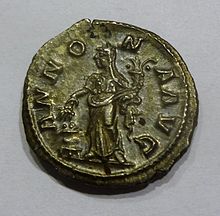Cura annonae
The cura annonae (from Latin cura "care", "supervision" and annona "annual yield", "food") was the supervision of the grain donations (annona civica) of the city of Rome in ancient times .
The annona civica
The original cura annonae was incumbent on the curulic aediles in the Republican era . One of their tasks was to buy grain on behalf of the state in the event of a famine and sell it to the citizens at low prices . The office also included the setting of the market price for grain regardless of yield and demand. With the growth of the urban Roman population and the simultaneous decline in agriculture in Italy, the grain increasingly had to be brought in from more distant provinces. The city of Rome had a monopoly on the grain from Sicily since the Punic Wars .
At the end of the republic, grain was distributed free of charge. Since the establishment of the monarchy by Augustus , the supervision of the distribution of grain was incumbent on an administration led by praefecti annonae , which the emperors appointed. Only those Roman citizens who were included in certain lists were entitled to receive; it wasn't about neediness. In the early and high imperial period, the grain was given out in the Porticus Minucia on the Marsfeld , and from the 3rd century also in other places. The grain came mainly from North Africa and Egypt; In late antiquity, however, the grain from the Nile went to Constantinople , whose population also received an annona civica since the 4th century .
The goddess Annona was depicted on Roman coins from the imperial era with a cornucopia and ears of corn or a corn shepherd (measure of capacity). She was also shown with a ship's bow for importing grain. The emperors, who had ultimately been responsible for the annona civica since Augustus, were thus celebrated as benefactors and providers of the city of Rome. Since the high imperial era, the annona civica no longer only comprised grain, but also North African olive oil as well as pork and wine from Italy.

The cura annonae outlived the end of the Western Roman Empire (476) by several decades; Since Gregory the Great , the church has taken over the supervision of the supply of the urban Roman population, which has since shrunk, and followed different rules.
The annona militaris
In the Principate and Late Antiquity , a distinction must be made between the annona civica , i.e. the donations of grain to the citizens of Rome (and from the 4th century also those of Constantinople ), and the annona militaris . The latter referred to the maintenance of regular imperial troops as well as foederati foreign to the empire . Since the 4th century, the collection and redistribution of this annona , which from the 5th century could also be paid out in cash, was the most important task of the Praetorian prefects .
The pursuit of Germanic warrior associations to a regulated supply by the Roman State played during the so-called mass migration an important role: the sack of Rome by mutinous Visigoth foederati in 410 had caused not least by the fact that the imperial government mercenaries sufficient annona militaris had to concede want. The mutiny of Anglo-Saxon warriors in Britain, which in the long term was to lead to the emergence of England , seems to have sparked a few years later from disputes about the amount of the annona allocated to the warriors .
literature
- Peter Herz : Studies on Roman economic legislation. The food supply. Franz Steiner, Stuttgart 1988, ISBN 3-515-04805-7 .
- Evelyn Höbenreich : Annona. Legal aspects of the Roman food supply in principle . Leykam, Graz 1997, ISBN 3-7011-8970-6 .
- Fritz Mitthof : Annona militaris. A contribution to the administrative and military history of the Roman Empire in the 3rd – 6th centuries. Century AD (= Papyrologica Florentina. 32). Florence 2001.
- Geoffrey Rickman: The Corn Supply of Ancient Rome . Clarendon Press, Oxford 1980, ISBN 0-19-814838-0 .
- Emin Tengström: Bread for the people: Studies of the Corn-Supply of Rome during the Late Empire . Aström, Stockholm 1974.
Remarks
- ↑ Titus Livius 2: 9, 6 ; 2.34 ; 10, 11, 9 .
